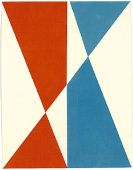Come visit DAAP Student, Betty Hensellek’s, exhibition on the postwar work of East German artist Hermann Glöckner at the library of Design, Architecture, Art, and Planning (DAAP) at the University of Cincinnati. It is a modest show of an original print (1963), two original printed posters (1971 and 1987), two hand printed catalogues (1969 and 1976), and an out of print book (1983) that will be on display until June of 2011.
Living in Dresden and its suburbs for 98 years, Hermann Glöckner witnessed the construction, struggle, demise, and reconstruction of a single nation. The work displayed in this exhibition highlights his artist endeavors as a mature artist after previously experiencing two world wars, the chaotic Weimar Republic, the crimes of the Third Reich, and the division of Germany, which refashioned Dresden and Eastern Germany into the German Democratic Republic (Deutsche Demokratische Republik, DDR) as a communist Soviet Satellite State. Despite living through this turbulence and the shifting rigidity of censorship on culture in the DDR, Glöckner was able to find contentment and even optimism within the seemingly disconsolate political, economic, and social conditions.
Further reading:
1. Hermann Glöckner – Ein Patriarch der Moderne. Ed. by John Erpenbeck. Der Morgen. Berlin 1983
2. Die großen Dresdner. 26 Annäherungen. Ed. by Karin Nitzschke. Insel Verlag. Frankfurt am Main und Leipzig 1999
3. Günter Meissner: Allgemeines Künstlerlexikon: die bildenden Künstler aller Zeiten und Völker. K.G. Saur Verlag 1992. pp 198-201
Links:
1. Hermann Glöckner in the German National Library catalogue

